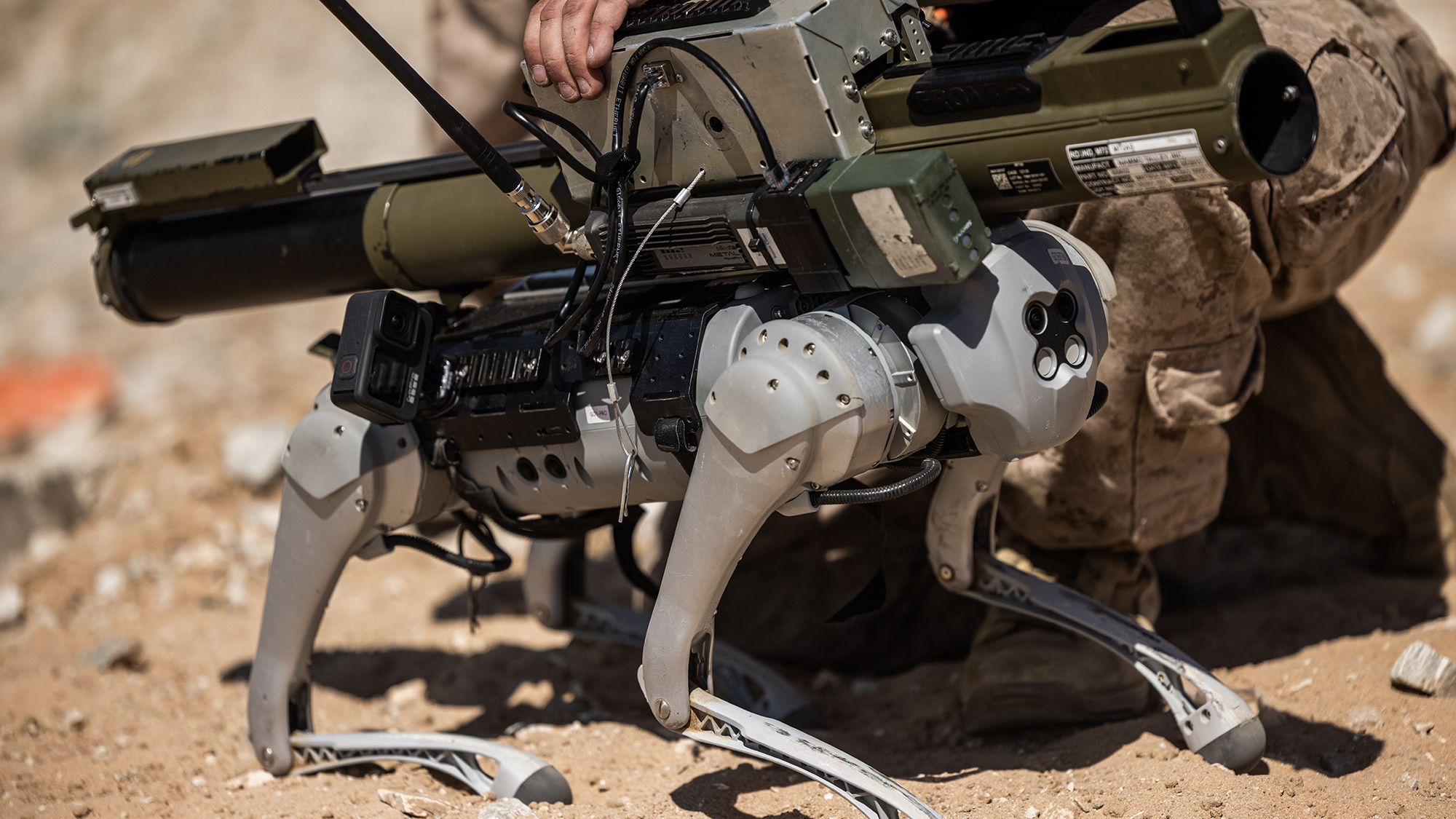

On September 9, Marines at Twentynine Palms, California, strapped a rocket launcher to the back of a commercially available robotic goat as part of a tactical training exercise. In a video of the test, the robotic goat is set up for safety on a firing range within a little sandbagged shelter, cleared to fire, and then the rocket-propelled grenade launches off the goat’s back. (While most quadrupedal robots of this size are referred to as robot dogs, the Marine Corps referred to the robot in question as a robotic goat.) The test, one of several new and autonomy-adjacent technologies demonstrated that day, offers a glimpse into what robot-assisted combat of the present and the future could look like.
The test was conducted by the Tactical Training and Exercise Control group, together with the Office of Naval Research, and it took place at the Marine Air Ground Task Force Training Command, which is the largest Marine Corps base. The rocket-propelled grenade launcher used was an M72 Light Anti-tank Weapon (or LAW). The weapon is a NATO standard, and thousands of the weapons have been delivered to Ukraine since it was invaded by Russia in February 2022.
The M72 LAW has been in service with US forces since 1963. Weighing just 5.5 pounds, the weapon is light, cheap enough to discard after firing, and dead simple to use. A Marine Corps guide notes that it is a standard tool of infantry battalions (which includes roughly 800 Marines). The weapon is also not specific to any line of service and “can be fired by any Marine with basic infantry skills.”
[Related: The US military’s tiniest drone feels like it flew straight out of a sci-fi film]
The rockets fired by the launcher can travel up to 3,280 feet, but are most effective at a range of 650 feet. That’s a dangerously close distance to be near a tank, as it places the person trying to destroy the tank within range of not just the tank’s big cannon but also any machine guns it may have for self-defense. This danger is exacerbated for armies fighting in open fields, but the M72 was designed for the density and obstructions of urban combat. All of those features, from simplicity to disposability to close-range firing, make it an ideal weapon to mount on a remote-controlled robot shooter.
“Instead of having a Marine handle the weapon system, manipulate the safeties, we could put a remote trigger mechanism on it that allowed it to all be done remotely,” said Aaron Safadi, in a release on the test. Safadi is the officer in charge of the emerging technology integration section of the Tactical Training and Exercise Control group. “The Marine could be behind cover and concealment, the weapon system could go forward, and the Marine could manipulate the safeties from a safe place while allowing that weapon system to get closer to its target.”
The robot goat on which the Marines tested the M72 is, as a Marine emphatically explains in the video, a tool for testing and not the intended robot for carrying it into combat. As reported by The War Zone, “the underlying quadrupedal robot is a Chinese-made Unitree Go1, which is readily available for purchase online, including through Amazon.” (The War Zone is owned by PopSci’s parent company, Recurrent Ventures.)
In the past, security concerns about using off-the-shelf robotics and drones made in China have led to the Department of Defense banning their use without explicit waivers for permission. That’s left the Pentagon in a sometimes tricky spot, as the overwhelming majority of commercial manufacture of such robots is in China, to the point that even models branded Made in USA have Chinese components.
Both Ukraine and Russia have adopted off-the-shelf commercial robots for use in their war against each other. The low price point of the Go1 goat robot suggests it could follow a similar pattern, should it prove useful as a remote-control firing platform. The Marine Corps, should it pursue a different mount for the M72, could pursue a platform like the Ghost Robotics Q-UGV. This four-legged robotic dog has already seen use patrolling an Air Force base in Florida, and in 2021 Ghost demonstrated a version of the Q-UGV with a gun mounted on its back at a defense technology exposition.
To mount the M72 on the robot goat, the robot first dons a metal box with firing controls and safety switches on its back. After firing, the box can be opened, the spent launcher discarded, and the robot is ready to take on a new round. It is easy to see the appeal of such a system in combat. With the M72 designed to punch through armor or defenses at short range, the driver could use a video-game-like controller to scout ahead, watching through the robot’s cameras as eyes. Sensors on the side of the robot help it avoid other obstacles. Once it’s in position, the robot’s rocket could be launched, and if the robot survives the encounter, it could let the Marine witness the destruction before advancing.
Bringing tanks or other armored vehicles into cities is already a fraught decision, as urban combat necessitates reduced perception. Cities, even ones reduced to rubble, can hide all sorts of waiting unpleasantness. For urban defenders and assaulters alike, the ability to mount weapons on robotic scouts, even and especially disposable robots with disposable weapons, offers a way to take a first toe into urban combat without exposing troops to excess danger.
Watch a video of the robot goat, and other items test in the training exercise, below:

